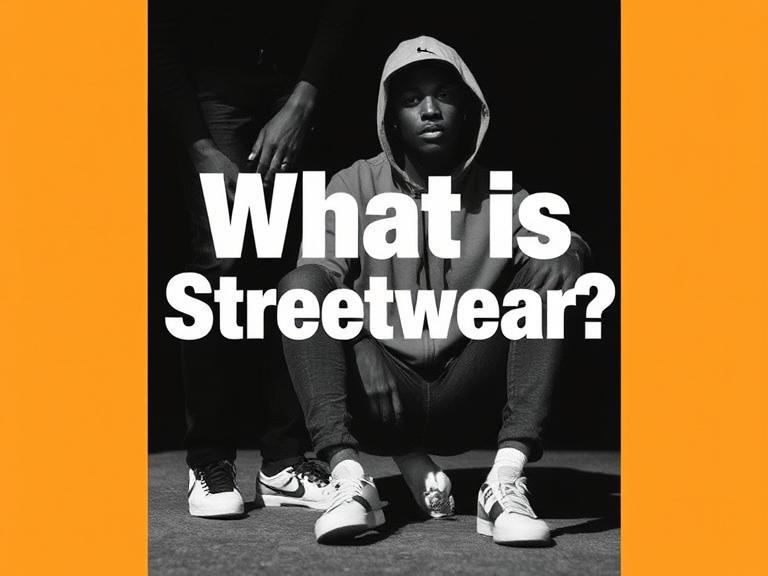
What Is Streetwear? Origins, Evolution, and Modern Influence
Share
Streetwear was never born in a boardroom. It didn’t roll out of some glossy fashion campaign. It came from the streets—literally. From skate parks in California to the booming hip-hop scene in New York, kids who didn’t see themselves in the pages of Vogue or GQ decided to write their own style rules. Hoodies became statements, sneakers became status symbols, and T-shirts carried as much weight as mixtapes.
What started as a rebellious DIY uniform is now a multibillion-dollar industry that makes luxury brands chase after it. And yet, the core of streetwear hasn’t changed—it’s still about identity, self-expression, and community. The difference? Today, it’s global, digital, and louder than ever.
Let’s break down how streetwear grew from underground subculture to the uniform of the Final Bo$$$.
Origins of Streetwear

Back in the late ’70s and ’80s, streetwear wasn’t on glossy magazine covers—it was living on sidewalks, basketball courts, and skate parks.
-
Surf & Skate Crew (California): Shawn Stüssy was literally scribbling his signature on surfboards before slapping it on tees and hoodies. His designs fused surf chill with skate edge, becoming a uniform for rebels who didn’t fit the preppy mall aesthetic.
-
Hip-Hop Takeover (New York): Across the country, hip-hop artists were repping oversized jackets, chunky sneakers, and tracksuits. Run-D.M.C. straight-up made Adidas shell toes iconic without even trying—okay, maybe with a little rap anthem called “My Adidas.”
-
’90s Wave (Exclusivity Era): Supreme started as a humble skate shop in NYC, then turned into the streetwear Holy Grail. Japan’s BAPE brought cartoonish camo and shark hoodies into the scene. Suddenly, streetwear wasn’t just about clothes—it was about culture drops, waiting in line, and being in the know.
Streetwear wasn’t polished; it was raw. DIY graphics, bootleg logos, custom gear—it screamed “I don’t care what’s in Vogue, this is my lane.”
Evolution of Streetwear

Fast-forward to the late ’90s and early 2000s—streetwear went from subculture to center stage.
-
Limited Drops: Brands realized scarcity = hype. Sell 200 hoodies, and boom—you’ve got kids camping on sidewalks for a week.
-
Collabs with Luxury: Once Supreme linked up with Louis Vuitton, the whole game flipped. Suddenly, luxury houses wanted streetwear clout. Balenciaga dropped chunky sneakers, Dior teamed with Jordan—high fashion and the streets officially started dating.
-
Influencer Power: Instagram, TikTok, and forums like Hypebeast democratized fashion. You didn’t need Anna Wintour’s approval—you just needed a killer fit pic. The streets started setting trends faster than Milan or Paris could keep up.
Streetwear wasn’t just “hoodies and kicks” anymore; it became the cultural handshake between rebellion, celebrity influence, and fashion authority.
Modern Influence of Streetwear

Today, streetwear is more than a fit—it’s a philosophy.
-
Inclusivity > Exclusivity (kind of): While limited drops still fuel hype, Gen Z demands inclusivity. Everyone should have a seat at the table—whether you thrift, buy designer, or DIY.
-
Sustainability Check: Fast fashion got canceled (at least in theory). Upcycled gear, ethical materials, and slow drops are hot topics. Streetwear brands now flex green creds as hard as they flex collabs.
-
Global Mash-Up: K-pop idols rock oversized street fits, Nigerian designers remix streetwear with traditional patterns, and TikTok creators are rebranding vintage sportswear as new. Streetwear is no longer just “American youth culture”—it’s everywhere.
-
Identity Armor: Whether it’s a hoodie with protest art or sneakers that tell your story, streetwear has become cultural armor—part expression, part resistance, part community.
It’s no longer just about “looking cool.” It’s about being seen.
FAQs About Streetwear
What actually counts as streetwear?
Why is streetwear so expensive?
But don’t worry—Final Bo$$$ offers the trendy and latest streetwear collection at reasonable prices. Buy now and get a 10% discount.
Is streetwear still “cool” in 2025?
How do I start building a streetwear style?
What’s the future of streetwear?
How Final Bo$$$ Stands Out:
Streetwear was never about fitting in—it was always about standing out. What started as surfboards, mixtapes, and skate decks is now sitting front row at Fashion Week and running the resale economy. And Gen Z? You’re not just wearing it—you’re rewriting the playbook.
Streetwear isn’t fashion. It’s flex, it’s protest, it’s identity. It’s the uniform of the Final Bo$$$.
